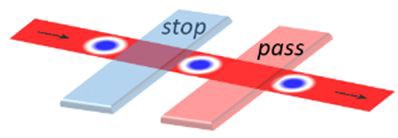
Host: Institut Néel, CNRS
Location: Grenoble, France
Supervisors: Stefania Pizzini, Laurent Ranno, Jan Vogel
Scientific project:
Chiral Néel walls and magnetic skyrmions are swirling spin textures with nanoscale dimensions and a non-trivial topology. In thin magnetic films, they are stabilized by interfacial Dzyaloshinskii-Moriya interaction. On the other hand, the recent observation [1] of skyrmions at room temperature in conventional transition-metal-based magnetic multilayers (collaboration SPINTEC/Institut Néel) is promising for spintronics applications including magnetic memories and logic gates. The Micro and Nanomagnetism group at Institut Néel (CNRS-Grenoble) had pioneered the control of magnetic properties with electric field gating [2]. Recently, we have demonstrated the electric field control of domain wall motion [3] and the possibility to control the skyrmion nucleation, annihilation and stability with electric field gating [4]. We have also developed an analytical model that allows us to predict skyrmion stability as a function of the thin films morphology and magnetic properties [5].
The objective of this project is threefold. First, based on our model, we will engineer materials in which skyrmions will be stable at room temperature and mobile under the application of spin polarized current pulses. Second, an elementary device will be conceived: skyrmions will be injected in a narrow strip, along which they will be displaced by current; local sub-micrometric local gates will serve to nucleate, annihilate and control their position. The third aspect will be carried out in collaboration with the Technical University of Eindhoven where we will combine the aforementioned achievements with the possibility to nucleate domain walls and skyrmions with ultrafast light pulses.
The chosen candidate tasks will be: (i) to select and optimize the magnetic properties of thin films (typically Pt/Co/oxide stack) with perpendicular anisotropy where skyrmion-bubbles spontaneously appear. (ii) in cleanroom environment, to process the films in nanostructures for current/field displacement of chiral domain walls and skyrmion bubbles (iii) to use local gates to characterise the gating dependence of the dynamics of domain walls and skyrmion bubbles.
The skyrmion/domain wall dynamics will be observed by Magneto-Optical Kerr microscopy, Magnetic Force Microscopy (MFM) and synchrotron radiation techniques.
The analytical model will be applied to well characterized materials to predict the dynamical properties of the skyrmions (nucleation, collapse, mobility). Moreover, the model will be used in a predictive way to propose the most efficient way to nucleate, propagate, pin and release skyrmions using electric gates and hot spots.
1. Boulle, O. et al. Room-temperature chiral magnetic skyrmions in ultrathin magnetic nanostructures. Nat Nano 11, 449 (2016).
2. Weisheit, M. et al. Electric Field-Induced Modification of Magnetism in Thin-Film Ferromagnets. Science (80-. ). 315, 349–351 (2007).
3. Bernand-Mantel, A. et al. Electric-field control of domain wall nucleation and pinning in a metallic ferromagnet. Appl. Phys. Lett. 102, 122406 (2013).
4. Schott, M. et al. The skyrmion switch: turning magnetic skyrmion bubbles on and off with an electrci field. Nano Lett. 17, 3006 (2017)
5. A. Bernand-Mantel et al. The skyrmion-bubble transition in a ferromagnetic thin film; SciPost Phys. 4, 027 (2018).
